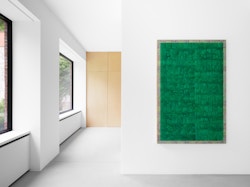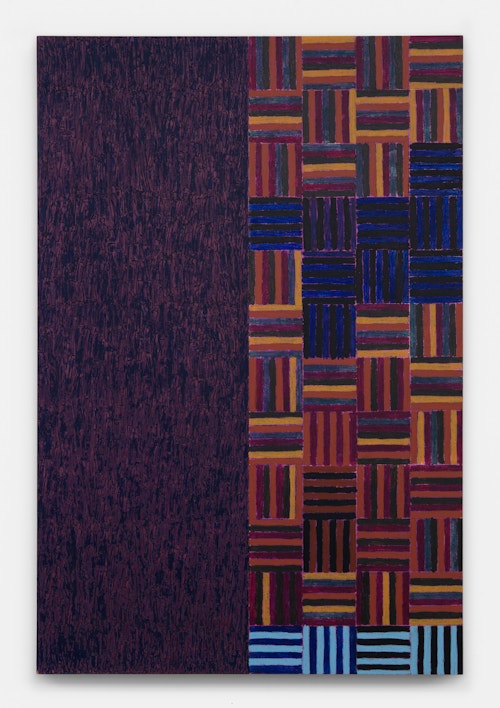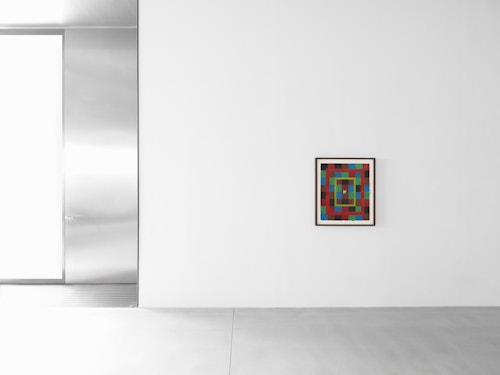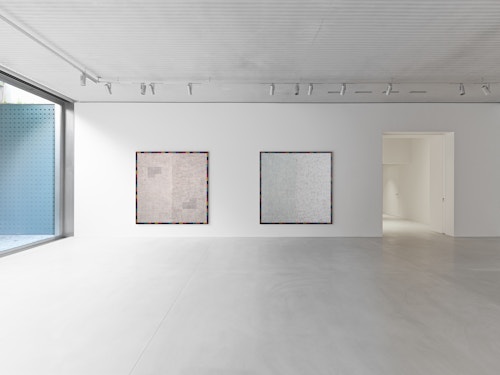
McArthur Binion Rawness Dancing:With Intellect
Rawness Dancing:With Intellect is an exhibition dedicated to the pioneering work of American artist McArthur Binion (b. 1946, Mississippi). Curated by Anne Pontégnie, it showcases the development of Binion’s work over the course of the last 15 years. Different series are brought together for the first time, divided into three themes across three floors. Highlights include a rare early work from 1985, together with a series of DNA works, the never previously exhibited Haints series (2014) and a group of six new Visual:Ear paintings (2023-24). McArthur Binion’s work blends elements of minimalism and conceptualism with autobiographical and cultural narratives, resulting in paintings and drawings that are both visually compelling and emotionally resonant. Over the years, his art has evolved through changes in technique, theme, and the exploration of personal and historical memory. The title alludes to the harmony between emotional and physical labour, as described by the artist: “my intellect and rawness are dancing together”.
The exhibition opens with McArthur Binion’s latest paintings in the Visual:Ear series, a tribute to Jazz records of particular significance to the artist. The series comprises of 12 paintings in total, half of which are exhibited here for the first time. The first room includes, for example, Visual: Ear (Maestro Duke), a tribute to Duke Ellington, and Visual:Ear (Unit Structures), honouring Cecil Taylor’s album. They are bordered with photographs of the musicians repeated alongside the edges of the paintings, a framing device reminiscent of quilts. The Visual:Ear paintings are a continuation of Binion’s exploration of music and visual abstraction, dating back to his time at the Cranbrook Academy of Art. It was here that he created Drawn Symphony:in:Sane Minor, a hand-drawn piece on musical manuscript paper, in 1971. Binion introduced the ‘visual ear’ concept in his 1973 graduation thesis, which represents his first attempt to visualise music. The current Visual: Ear series began in 2021, with each painting built on a collaged base of musical scores. He calls this layer, which varies from series to series, the ‘underconscious’. Using oil sticks, Binion creates dense, repetitive markings that form geometric patterns and grids, partially hiding the initial imagery. This interplay of concealment and revelation invites viewers to explore the music-inspired and personal narratives within the artwork. Born in Mississippi, the birthplace of the blues, Binion was immersed in a cultural milieu that valued rhythm, improvisation and storytelling – qualities that still reverberate through his work. Within the gridded compositions, he combines methodical, dynamic structures with layering techniques, similar to the rhythms and improvisation of blues and jazz. Binion uses music as a source of creativity and a way of analysing the structure and emotions in his work. The lighter variants of the series are displayed on the floor below.

The Haints series (2014) in the adjacent rooms consists of ten works that explore the artist’s Mississippi roots and Southern upbringing. Haint is an alternate spelling of ‘haunt’, a term used by African-Americans to describe ghosts or restless spirits. McArthur Binion elaborates: “They involve reverse maps of Mississippi, and are an extension of the DNA:Studies. They are larger self-portraits about who I am and how I live – all the information is there. These works are specifically about me. They are about my involvement with haints and Mississippi... Haints are about people that you knew that are dead – so the ghosts are real. It’s really emotional with the work.” In a break with his typical practice, the Haints are devoid of an underconscious. He continues: “I associate the haints with the legend of people down South crawling out of their skin; I’ve been looking for haints all of my life. The haints swirl around all of the maltreatment that has happened in Mississippi for centuries and centuries – the lynchings, the rape, the regular straight up murders, etc. My father worked seven days a week and made $7.32 per week. So I know what haints are.”
A selection of the artist’s DNA:Studies are shown on the first floor, alongside smaller format works from both the Hand:Work and Visual:Ear series. Colour, autobiography and technique are key focal points in this display. Binion’s DNA:Studies, a subset of the broader DNA series, is a cornerstone of his practice. Central to this body of work is Binion’s replication of his old address and telephone book as the underconscious, a uniquely private artefact that encapsulates years of relationships, connections and memories. With its handwritten entries and worn pages, the book is a literal and symbolic repository of his life experiences. He says: “Each day for the months I painted those, I relived every day of my life because of all of those names.” The names and numbers, partially obscured by layers of oil stick or crayon, are visible upon close examination, adding a narrative layer to the otherwise austere, minimalist grids. The repetitive mark-making, a hallmark of Binion’s practice, recalls the meditative labour of memory and identity formation. It also evokes the physicality and discipline of his early life, spent working on a farm in rural Mississippi.
This contemplative yet physically demanding process also transforms the grid into a tangible record of the artist’s presence. His gestures both conceal and reveal, creating a dynamic tension that reflects the complexity of memory and identity. Binion’s works are thus defined by the proportions of his body, such as hand span and arm length, as well as his physical agility. In the series Hand:Work, Binion makes this connection explicit by incorporating images of his own hand into the underconscious. By foregrounding the physical nature of his practice, Binion challenges the impersonal, mechanical associations of abstraction and minimalism. His art becomes a testament to the interplay between the intellectual and the corporeal, the personal and the universal. Through this embodied approach, Binion transforms the act of making art into a profound exploration of what it means to inhabit a body and a history. He creates works that are as much about the process of becoming as they are about the final form.

McArthur Binion lives and works in Chicago. His works were featured prominently in the 57th Venice Biennale, VIVA ARTE VIVA. Solo exhibitions of his work have been organised at Peter Marino Art Foundation, Southampton, NY, USA (2024); Museo Novecento, Florence, Italy (2020); the Cranbrook Art Museum, Bloomfield Hills, MI (2018); the Contemporary Art Museum, Houston, TX (2012). Binion’s work is in numerous public and private collections and his most recent venture is the Modern Ancient Brown Foundation that provides funding and workspaces to help young visual artists and writers of colour find their voices.

























































